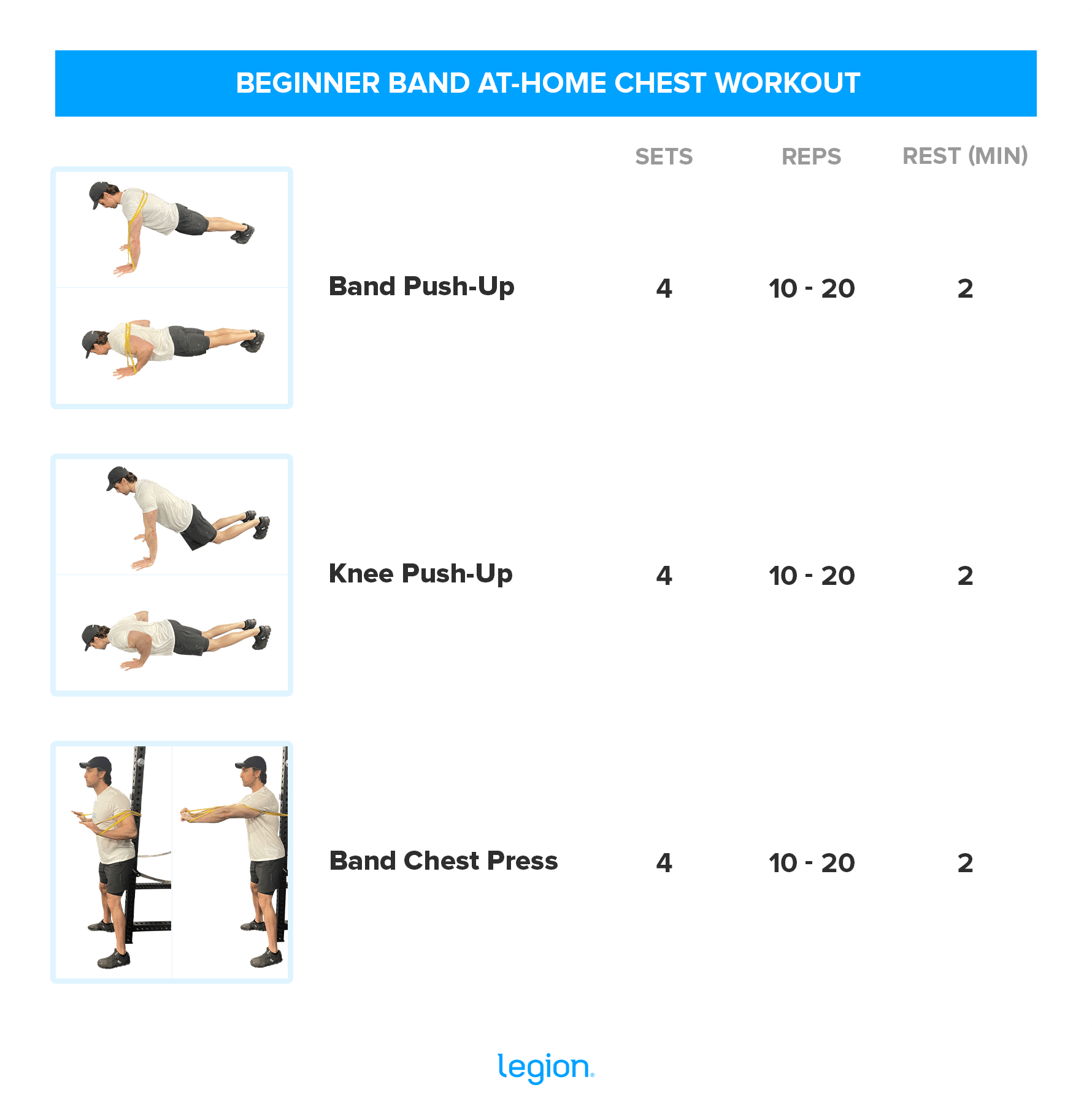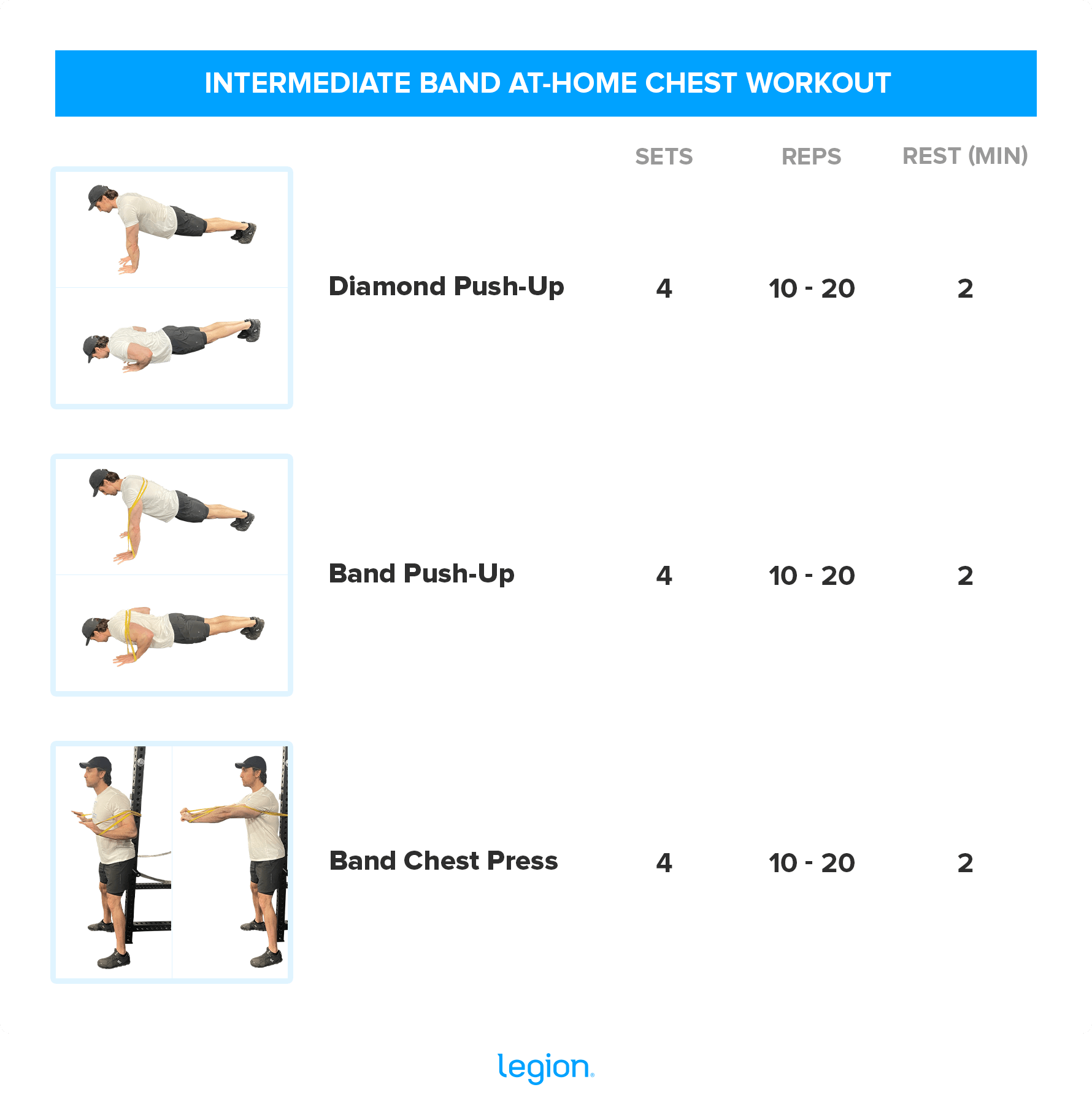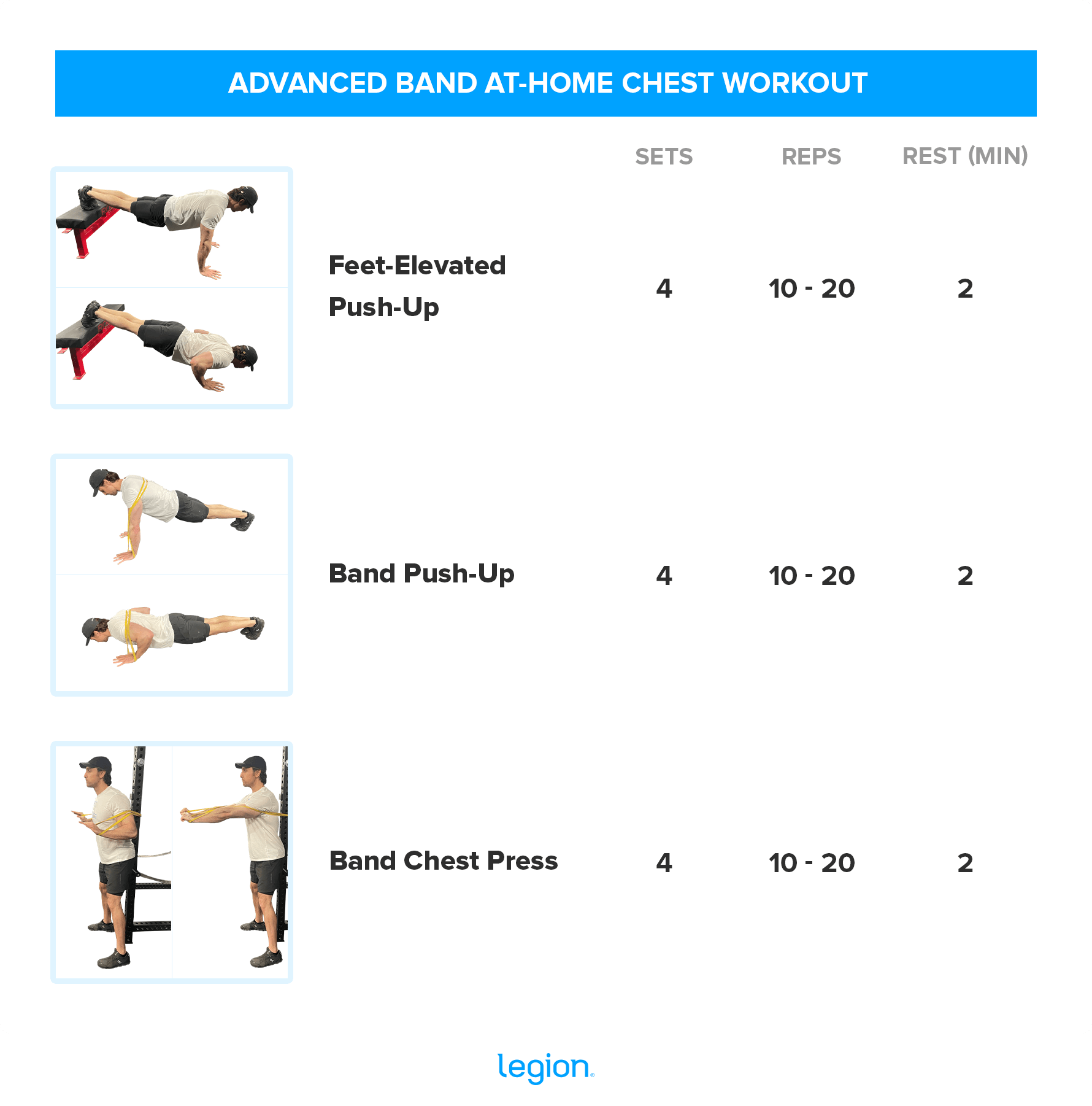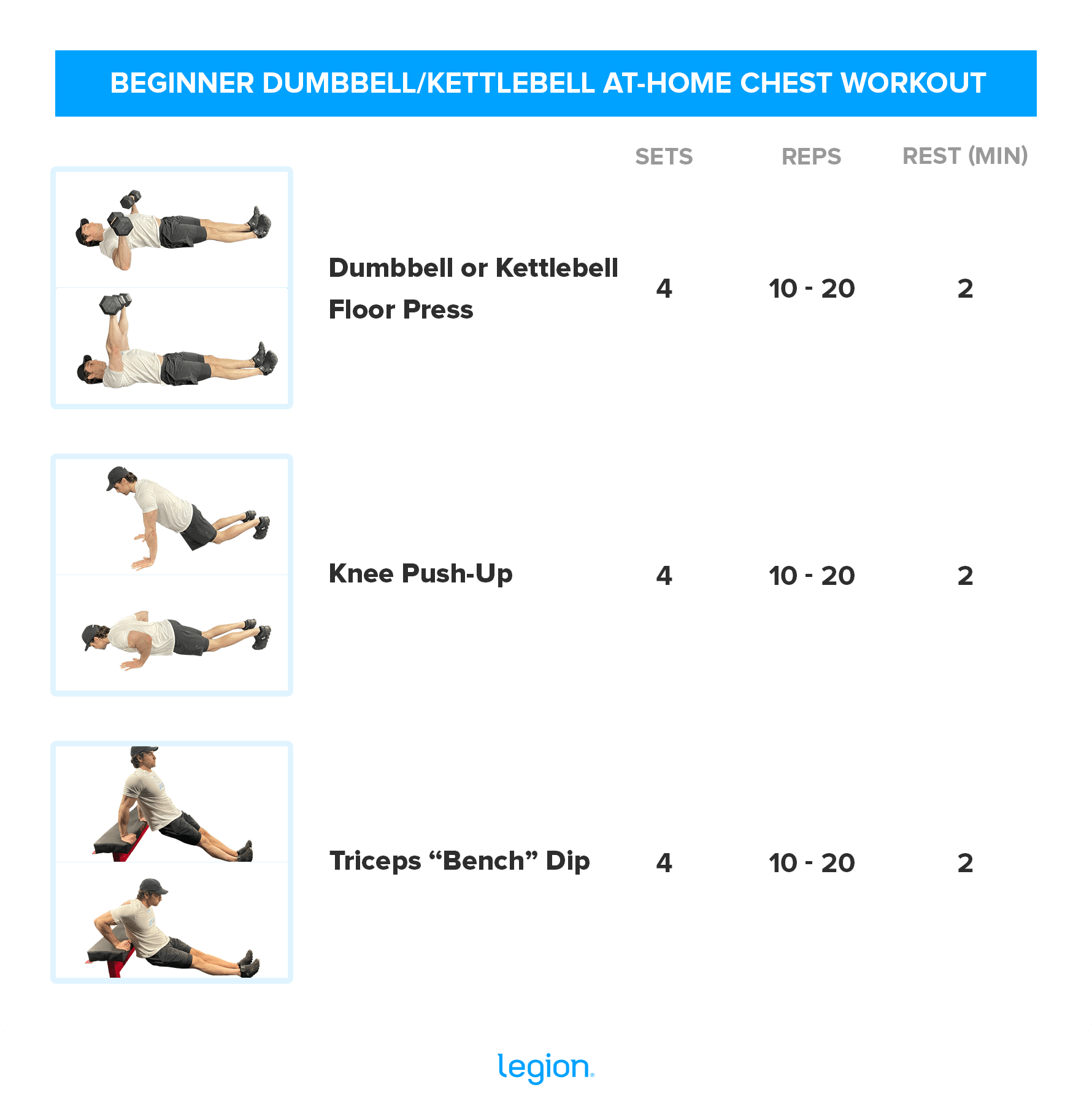Fact Checked
Evidence Based
Many serious gymgoers think at-home chest workouts are a waste of time.
By their lights, no amount of push-ups, band presses, or bodyweight dips will compare to training with barbells, dumbbells, and machines.
What’s more, they say, even if they were effective, at-home workouts (chest or otherwise) would still get stale faster than a loaf of bread in a hobo’s backpack.
In reality, though, at-home chest workouts don’t have to be a fruitless grind.
Design them well, and you should be able to maintain—or perhaps even gain—muscle with bodyweight workouts alone. And if you get your paws on some bands or dumbbells, you’ll be able to retain much of your strength, too.
We’ll break it all down in this article. You’ll also get 12 weeks’ worth of free at-home chest workouts, all expertly laid out in Google sheets.
Let’s get started.
The Anatomy of the Chest Muscles
The primary chest muscle is the pectoralis major, or “pec major.” Here’s what it looks like:
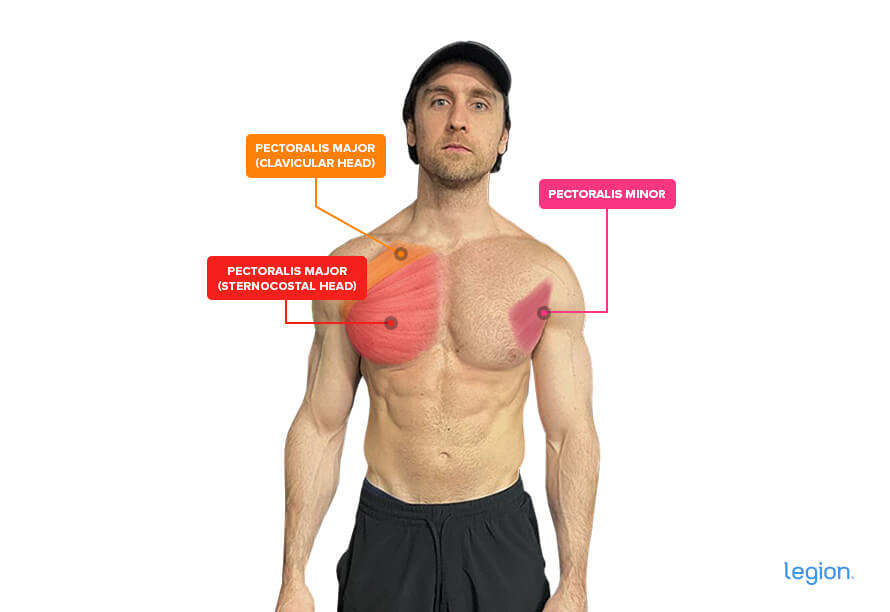
As you can see, the pectoralis major has two sections or “heads:” the sternocostal head (“lower chest”) and clavicular head (“upper chest”). Thus, to develop full, proportional pecs, your chest workouts at home must include exercises that emphasize both sections.
The other noteworthy part of the pecs is the pectoralis minor. The “pec minor” lies underneath the pectoralis major and pulls the shoulder blade forward and toward the middle of your chest.
Many of the same exercises that effectively train the pec major also involve the pec minor, so it’s not necessary to use specific at-home chest exercises for the pec minor (and even if you did, it’d be hard to see whether or not your pec minor was growing).
The Simple Science of Effective At-Home Chest Workouts
Creating an at-home chest workout is just like putting together any other chest workout, but with more constraints.
You probably won’t have the hardware (e.g., a bench and a barbell) that most chest workout routines call for. Instead, you might only have your bodyweight, some resistance bands, and perhaps a few dumbbells or kettlebells.
Bare-bones setups like this make it challenging to progressively increase the weights you lift. This is significant because lifting heavier weights over time (known as progressive overload) is the primary driver of muscle and strength gain.
[Read More: Is Getting Stronger Really the Best Way to Gain Muscle?]
So, how should you progress in your at-home chest workouts? You have several options:
1. Do more reps or sets.
High-rep sets (more than 10 reps) tend not to be much fun, but they can be just as effective for building and maintaining muscle as low-rep sets if you push close to failure.
However, this only holds true for sets up to about 20 or 30 reps—doing 100 reps to failure isn’t as beneficial for muscle growth as doing 20 reps to failure.
Doing more sets can also be an effective strategy for goosing strength and muscle gain—even with bodyweight exercises—but it also quickly hits a point of diminishing returns.
Doing more than 12-to-15 sets per muscle group per workout or more than 15-to-20 sets per muscle group per week usually doesn’t lead to additional gains and raises the risk of repetitive strain injuries (RSI).
2. Use more challenging exercise variations.
For example, feet-elevated push-ups instead of regular push-ups or band push-ups instead of feet-elevated push-ups.
This can buy you a few more weeks or maybe even months of progress, but you’ll eventually run into the same problems—your workouts won’t be difficult enough to keep gaining muscle and strength.
3. Use bands or dumbbells.
Using bands or dumbbells can make your workouts significantly more challenging, enjoyable, and productive—enough to continue gaining muscle and strength even without a “real” home gym.
How effective can chest workouts at home really be, though?
If you’re a beginner weightlifter (less than a year of weightlifting experience), you can effectively gain chest muscle and strength with at-home chest workouts.
You won’t progress as quickly as you would if you were following a barbell-based training plan, but you’ll get noticeable results.
And if you’re more advanced, you can probably maintain most of your chest size and strength with pec workouts at home for at least a month or so. If you have bands, you can probably extend this by another month (or possibly more).
And if you have a heavy enough set of dumbbells, you can maintain your physique more or less indefinitely (although you’ll likely lose some strength).
I’m a prime example of how effective chest workouts at home can be. I used the same kinds of at-home chest workouts you’re going to learn in this article to easily maintain my muscle mass (while losing body fat) when my gym was closed for several months in early 2020.
Here’s a pic of me in late 2019 before the Covid lockdowns (left) and one of me after several months of chest workouts at home:
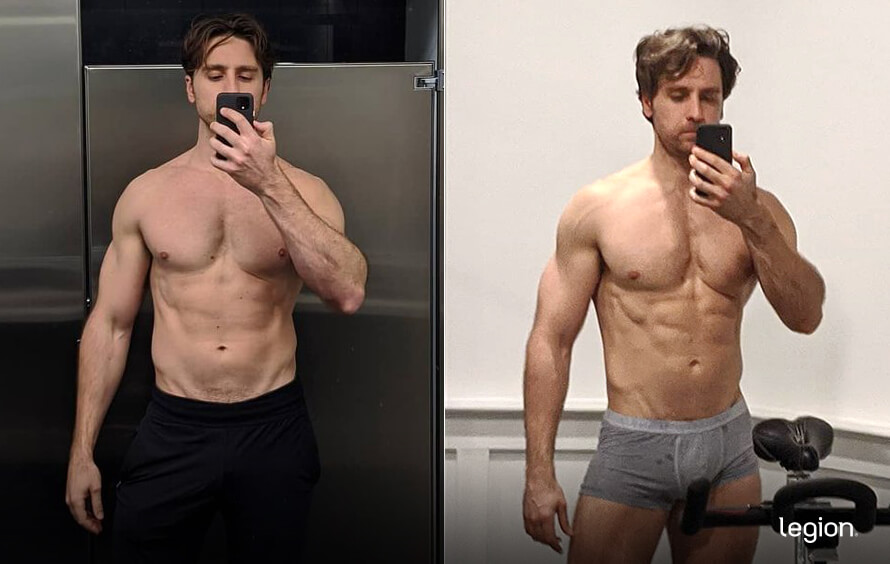
Not too different, I’m sure you’ll agree.
Alright, with that nerdy knowhow out of the way, let’s get to the at-home chest workouts.
The Legion At-Home Chest Workouts
These at-home chest workouts are ideal if you have no equipment whatsoever. Just choose which suits your experience level best and follow the routine as it’s laid out.
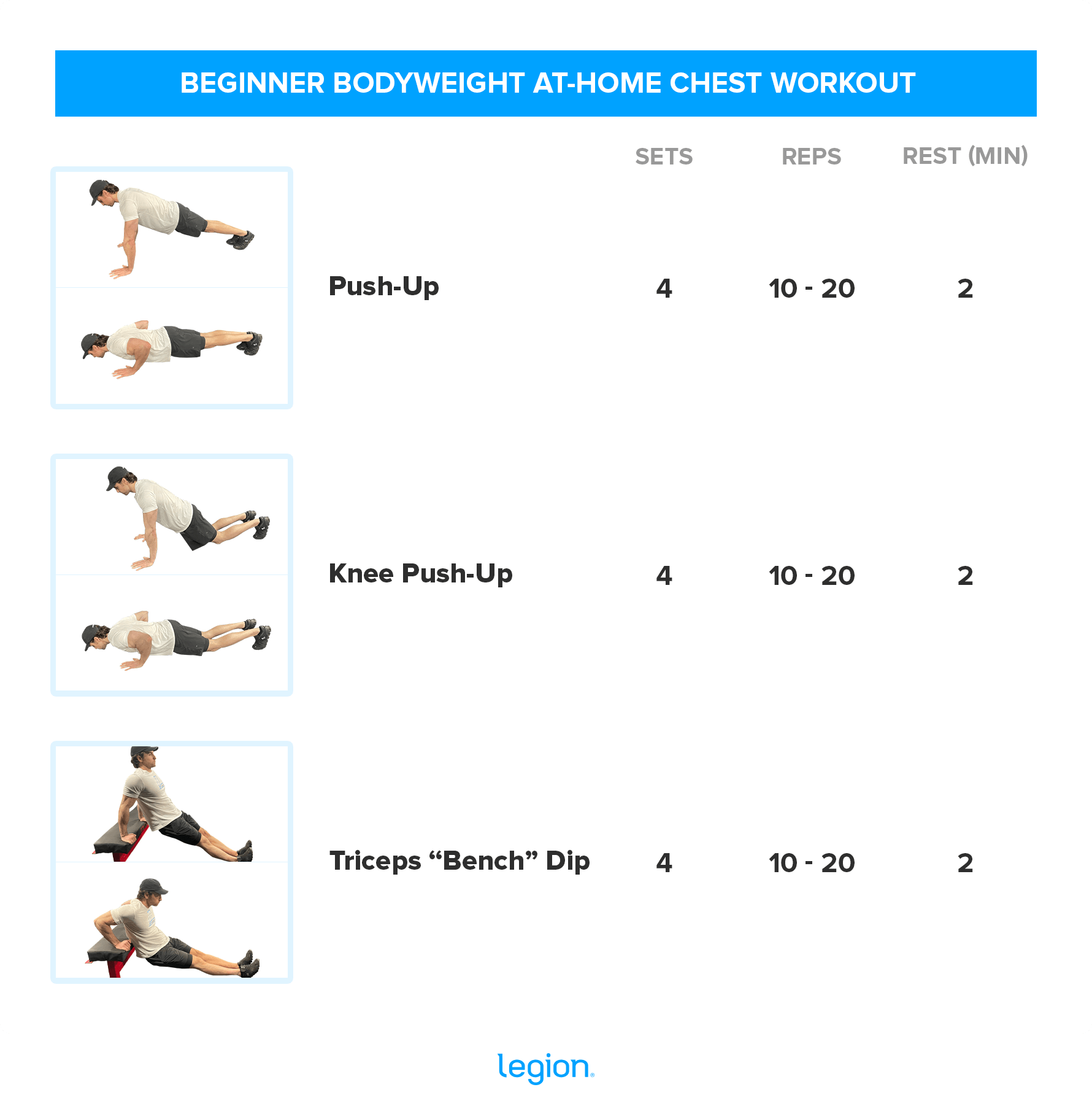
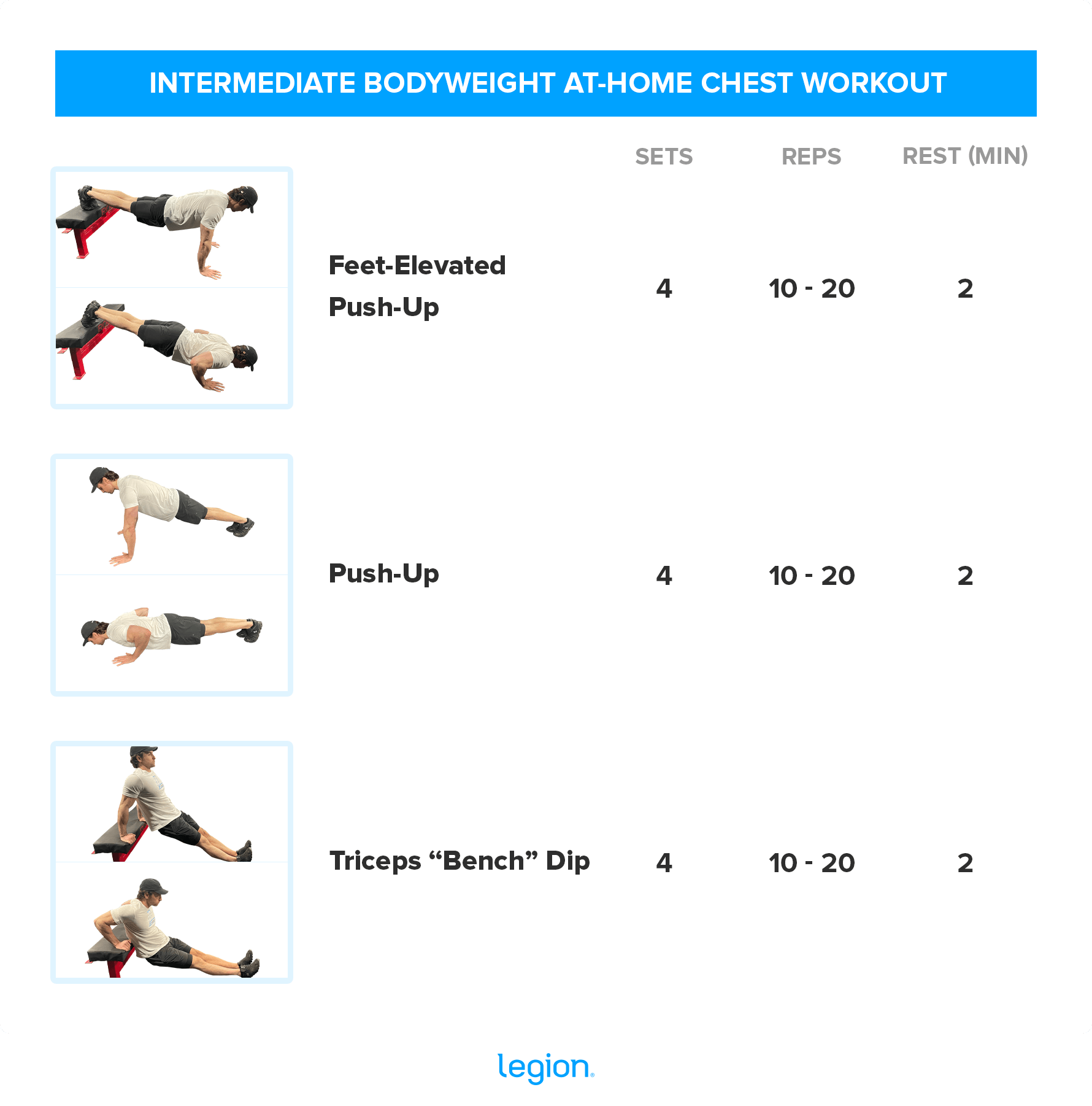

The Legion Band At-Home Chest Workouts
Getting your mitts on a few resistance bands can make a big difference to your pec workouts at home. In fact, research shows that for most people, training with bands is enough to help you maintain all your muscle and strength.
Here are three resistance-band chest workouts for every fitness level:
The Legion Dumbbell/Kettlebell At-Home Chest Workouts
These at-home chest workouts with dumbbells or kettlebells are excellent for gaining chest size and strength:
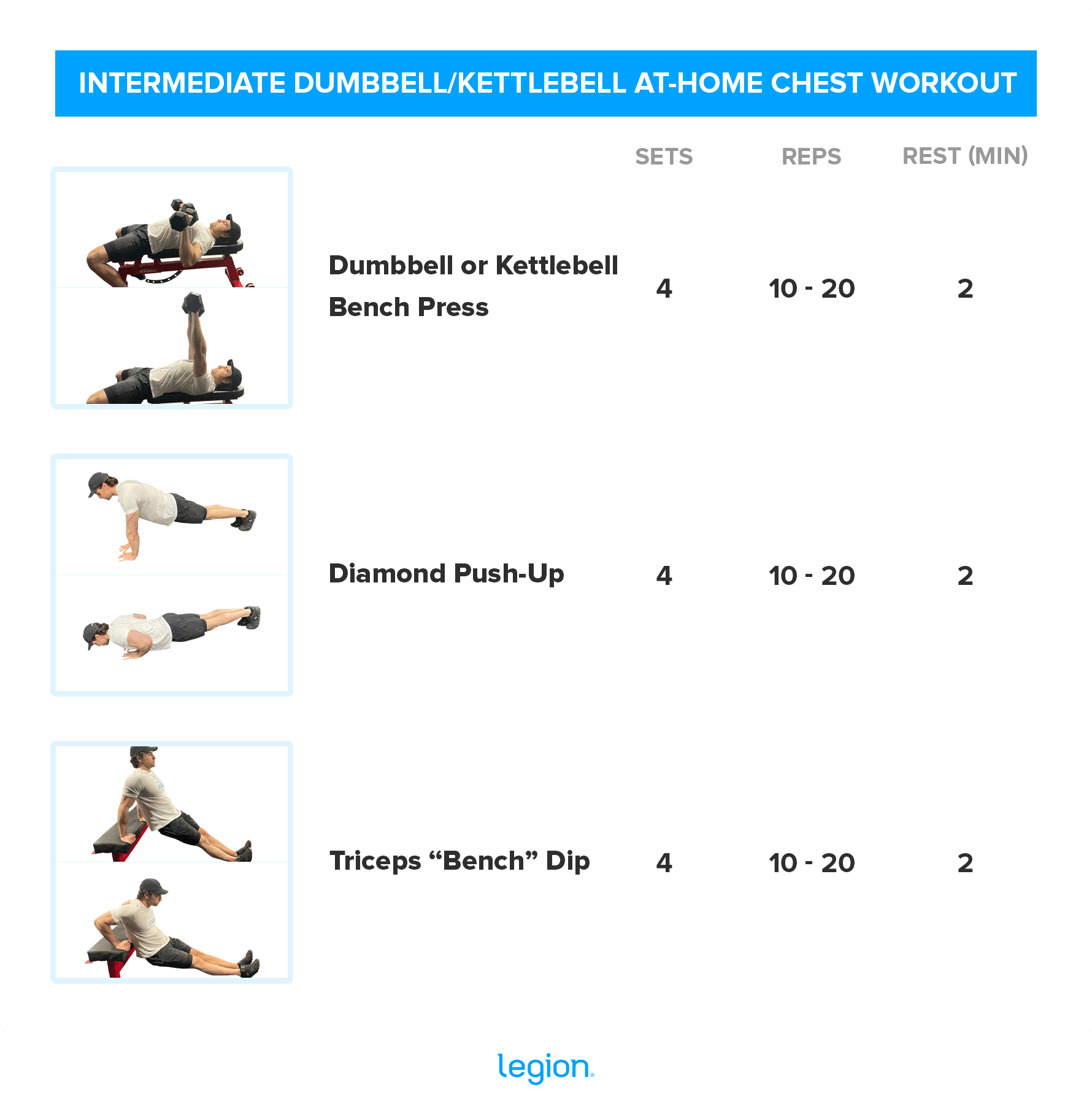

3 Tips for Better At-Home Chest Workouts
1. Do two chest workouts per week.
For best results, I recommend doing at least two chest workouts per week separated by at least one day where you don’t train your chest (a rest day or lower body workout day).
For example, you could do your at-home chest workout on Monday, train other muscle groups, do cardio, or rest on Tuesday and Wednesday, then repeat your chest workout again on Thursday.
Here’s an example of what this would look like throughout the week if you were also doing dedicated back and lower-body workouts:

And here’s what this would look like if you only wanted to train three times per week:

2. End every set one or two reps short of absolute failure.
You don’t need to take every set to the point of absolute muscle failure, but you do have to come close.
You’ll learn to recognize this point the more you work out—it’s when you strain for a rep and feel pretty sure you won’t get the next one.
3. Rest a minute or two between sets.
You should rest long enough for your breathing and heart rate to settle down, but not so long that you lose your focus, which is usually around two minutes for at-home chest exercises.
The Best Equipment for At-Home Chest Workouts
The best way to maintain or gain strength and muscle with at-home chest workouts is to invest in a few pieces of equipment that allow you to more effectively implement progressive overload.
Here are the best ones:
- Push-up Handles: Push-up handles extend a push-up’s range of motion, which likely benefits muscle growth. They also take the strain off your wrists, which is helpful if you plan on doing at-home chest workouts for more than a few weeks (all those push-ups can beat up your wrists).
- Resistance Bands: Resistance bands add resistance to all kinds of exercises, including push-ups and chest presses.
- Dumbbells or Kettlebells: Picking up a set of adjustable dumbbells or a few kettlebells is the best way to make your at-home chest workouts even more productive.
- Adjustable Bench: Having an adjustable bench allows you to do more dumbbell and kettlebell exercises through a longer range of motion and more safely.
- Dip Stand: A dip stand is handy for doing a number of bodyweight exercises, especially dips. What’s more, if you also get a dip belt, you can incrementally increase the weight you lift by hanging weight from your waist.
+ Scientific References
- Baz-Valle, Eneko, et al. “Total Number of Sets as a Training Volume Quantification Method for Muscle Hypertrophy.” Journal of Strength and Conditioning Research, vol. Publish Ahead of Print, no. 3, 30 July 2018, https://doi.org/10.1519/jsc.0000000000002776.
- Calatayud, Joaquin, et al. “Bench Press and Push-up at Comparable Levels of Muscle Activity Results in Similar Strength Gains.” Journal of Strength and Conditioning Research, vol. 29, no. 1, Jan. 2015, pp. 246–253, https://doi.org/10.1519/jsc.0000000000000589.
- Hartmann, Hagen, et al. “Influence of Squatting Depth on Jumping Performance.” Journal of Strength and Conditioning Research, vol. 26, no. 12, Dec. 2012, pp. 3243–3261, https://doi.org/10.1519/jsc.0b013e31824ede62. Accessed 1 Nov. 2019.
- Kikuchi, Naoki, and Koichi Nakazato. “Low-Load Bench Press and Push-up Induce Similar Muscle Hypertrophy and Strength Gain.” Journal of Exercise Science & Fitness, vol. 15, no. 1, June 2017, pp. 37–42, https://doi.org/10.1016/j.jesf.2017.06.003.
- Pinto, Ronei S, et al. “Effect of Range of Motion on Muscle Strength and Thickness.” Journal of Strength and Conditioning Research, vol. 26, no. 8, 2012, pp. 2140–5, www.ncbi.nlm.nih.gov/pubmed/22027847, https://doi.org/10.1519/JSC.0b013e31823a3b15.
You May Also Like
Our Most Popular Evidence-Based Articles
You don’t need supplements to build muscle, lose fat, and get healthy. But the right ones can help.
Take our 60-second quiz now to learn which supplements can help you achieve your fitness goals faster.
Sending…
Your free stuff is on the way!
Follow the Diet Plan that Helped Nikita Lose 15 Pounds in 3 Months
“I never thought getting in shape would be this simple! Everything just WORKS when you follow this plan.” And if he can do it, why not you?

Wait!
Want a Free Custom Meal Planning Tool?
Quickly calculate your calories, macros, and micros for losing fat, building muscle, and staying healthy.
Our “No Return Necessary”
Money-Back Guarantee
If you don’t like something of ours, guess what happens next?
No, we don’t request you deliver it to a PO box in the Gobi Desert by carrier pigeon. Nor do we ask you to fill a cursed inkwell with orc’s blood and demon saliva and then use it to complete reams of return forms written in ancient Cyrillic script.
We just . . . wait for it . . . give you your money back. Holy moo cows. And that means you can say “yes” now and decide later.
Free Worldwide Shipping & Returns
Many companies use shipping and handling fees to increase their profit margins, but here at Legion, we hate profits, so our shipping is free!
Okay, so we do dig on profits, but we also go in for happy customers, and free shipping works like gangbusters. So, if you live in the United States, your order ships free regardless of order size, if you live in the UK, Canada, Puerto Rico, or Guam, your order ships free when it’s over $99, and if you live elsewhere, your order ships free when it’s over $199.
Also, if you don’t absolutely love our stuff for whatever reason, we don’t request you deliver it to a PO box in the Gobi Desert by carrier pigeon.
We just . . . wait for it . . . give you your money back. No returns. No forms. No nonsense. Holy moo cows.
That means you can say “yes” now and decide later. You really have nothing to lose.
Free Worldwide Shipping & Returns
Many companies use shipping and handling fees to increase their profit margins, but here at Legion, we hate profits, so our shipping is free!
Okay, so we do dig on profits, but we also go in for happy customers, and free shipping works like gangbusters. So, if you live in the UK, Canada, Puerto Rico, or Guam, your order ships free when it’s over $99.
Why the restriction on international orders? Unfortunately, shipping abroad is very expensive, and if we didn’t require a minimum order size, we’d lose a lot of money. But! We’re also hustling to improve our international logistics and will be passing our savings along to our international customers.
Also, if you don’t absolutely love our stuff for whatever reason, we don’t request you deliver it to a PO box in the Gobi Desert by carrier pigeon.
We just . . . wait for it . . . give you your money back. No returns. No forms. No nonsense. Holy moo cows.
That means you can say “yes” now and decide later. You really have nothing to lose.
Free Worldwide Shipping & Returns
Many companies use shipping and handling fees to increase their profit margins, but here at Legion, we hate profits, so our shipping is free!
Okay, so we do dig on profits, but we also go in for happy customers, and free shipping works like gangbusters. So, if you’re outside the USA, your order ships free when it’s over $199.
Why the restriction on international orders? Unfortunately, shipping abroad is very expensive, and if we didn’t require a minimum order size, we’d lose a lot of money. But! We’re also hustling to improve our international logistics and will be passing our savings along to our international customers.
Also, if you don’t absolutely love our stuff for whatever reason, we don’t request you deliver it to a PO box in the Gobi Desert by carrier pigeon.
We just . . . wait for it . . . give you your money back. No returns. No forms. No nonsense. Holy moo cows.
That means you can say “yes” now and decide later. You really have nothing to lose.
Clinically Effective Ingredients & Doses
Many ingredients in supplements don’t have any scientifically validated benefits, and many ingredients that do are often underdosed to the point of irrelevance.
That’s why we only use the choice ingredients and precise doses shown to be effective in peer-reviewed scientific studies.
Clinically Effective Doses
You need more than great ingredients to make great products—you also need proper doses. That’s why we use the precise doses of ingredients shown to be effective in peer-reviewed scientific studies.
Natural Ingredients
“Natural” doesn’t always mean “better,” but in many cases, natural ingredients are superior to artificial ones for various reasons, including purity, safety, and efficacy.
That’s why all of our ingredients in all of our products come from plant and animal sources, including sweeteners, colors, and flavors.
Made in USA with Globally Sourced Ingredients
If you want to ensure the supplements you’re swallowing every day are safe and effective, you want products produced in the USA.
That’s why all of our supplements are made in America in NSF-certified and FDA-inspected facilities that operate in accordance with the Current Good Manufacturing Practice (cGMP) regulations.
Lab Tested
Did you know that supplements can contain dangerously high levels of toxins like lead, arsenic, and cadmium?
That’s why we test every ingredient of every supplement we produce for heavy metals, microbes, allergens, and other contaminants and ensure they meet the strict purity standards set by the FDA.
Naturally Sweetened & Flavored
While artificial sweeteners may not be as dangerous as some people claim, studies suggest that regular consumption of these chemicals may indeed be harmful to our health.
That’s why all of our supplements are naturally sweetened and flavored and contain no artificial food dyes, fillers, or other unnecessary junk.
Science-Backed Ingredients
Many ingredients in supplements don’t have any scientifically validated benefits. That’s why we only use choice ingredients shown to be effective in peer-reviewed scientific studies.
No Chemical Junk
“Natural” doesn’t always mean “better,” but in many cases, natural ingredients are superior to artificial ones for various reasons, including purity, safety, and efficacy.
That’s why all of our ingredients in all of our products come from plant and animal sources, including sweeteners, colors, and flavors.


Split your entire online purchase into 4 interest-free payments, over 6 weeks with no impact to your credit.

25%
today
25%
2 weeks
25%
4 weeks
25%
6 weeks

Shop and add items to your cart as normal!

Choose Sezzle at Checkout! You’ll be redirected to Sezzle to Sign Up or Log In
to complete your order.

Your order will be shipped out right away* and your payments will be split up
over 6 weeks.
*shipping times subject to merchant shipping policy
Shop directory. Reschedule payments. Plus more!
Waiver and Release of Liability
In consideration of the services and/or products offered by Legion Athletics, Inc. (“Legion”) including, but not limited to, nutrition plans, exercise routines and coaching, and in addition to the payment of any fee or charge:
I knowingly and voluntarily enter into this waiver and release of liability and hereby waive any and all rights, claims or causes of action of any kind whatsoever arising out of my use of Legion’s services and/or products, and I hereby release and hold harmless Legion and its consultants, officers, contractors, agents, owners and employees from any and all responsibility, liability, cost and expenses, including for injuries, damages or disorders (physical, metabolic, or otherwise), resulting from my use of Legion’s services and/or products.
I understand that fitness activities including, but not limited to, strength, flexibility, and cardiovascular exercise, with or without the use of equipment, are potentially hazardous activities that involve a risk of injury and even death, and I am voluntarily participating in these activities and using equipment and machinery with knowledge of the risks involved. I hereby agree to assume and accept any and all risks of injury or death related to said fitness activities.
I understand Legion’s services and products are not meant to treat or manage any health conditions or circumstances, and I acknowledge that Legion has recommended I obtain a healthcare provider’s approval for my use of Legion’s services and/or products, through regular physical examination(s) and/or consultation. I acknowledge that I have obtained my healthcare provider’s approval or have decided to use Legion’s services and/or products without such approval and hereby assume all responsibility for my use of said services and/or products.
I understand that results from using Legion’s products and/or services are not guaranteed, and I agree to not hold Legion liable for any outcomes or lack thereof.
OUT OF STOCK
Security Check
Please click the checkbox below. We apologize for the inconvenience.
If you don’t absolutely love this product, just let us know, and we’ll give you a full refund on the spot. No forms or return necessary.
Analyzed for purity and potency in a state-of-the-art ISO 17025 accredited lab by Labdoor™, the gold standard of third-party lab testing.
Analyzed for purity and potency in a state-of-the-art ISO 17025 accredited lab, the gold standard of third-party lab testing.
This product doesn’t just “contain natural ingredients”—every ingredient is naturally sourced from plants and animals. This product contains no artificial or synthetic sweeteners or flavors of any kind.
Fact Checked
Our scientific review board of nutritionists, dietitians, molecular biologists, doctors, and other accredited experts is responsible for reviewing every article, podcast, and video we produce to ensure they’re evidence based, accurate, trustworthy, and current.
Thanks to their connections, credentials, and academic experience, this team of MDs, PhDs, and other professionals has access to a wealth of research published in the largest and most prestigious journals in the world.
This allows them to not only review individual studies but also analyze the overall weight of the evidence on any and all topics related to diet, exercise, supplementation, and more.
If you feel that any of our content is inaccurate, misleading, out-of-date, or anything less than factual, please let us know in the comments section of the article in question.
Evidence Based
We follow a detailed, rigorous, multi-step process to create content that meets the highest standards of clarity, practicality, and scientific integrity.
First, our research associates provide our editorial team with accurate, up-to-date, proven scientific evidence.
Then, our editorial team uses this research to draft articles and outlines for podcasts and videos.
Finally, our scientific review board reviews the content to ensure all key information and claims are backed by high-quality scientific research and explained simply and precisely.
If you feel that any of our content is inaccurate, misleading, out-of-date, or anything less than factual, please let us know in the comments section of the article in question.

